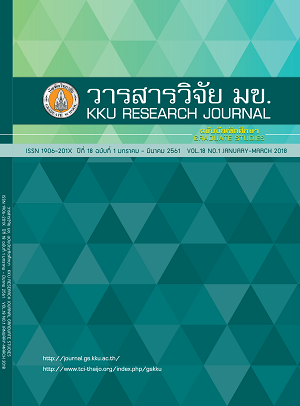ลักษณะการสุขาภิบาลที่พักอาศัยมีอิทธิพลต่อการเพาะพันธุ์หนูในตำบลหอไกร จังหวัดพิจิตร ประเทศไทย
Keywords:
การสุขาภิบาลที่อยู่อาศัย (Housing sanitation), ร่องรอยหนู (Rat sign), การเพาะพันธุ์ของหนู (Rat infestation)Abstract
การศึกษานี้มีวัตถุประสงค์เพื่อศึกษาความสัมพันธ์ระหว่างข้อบกพร่องทางสุขาภิบาลที่พักอาศัยและการพบร่องรอยหนูในบ้านที่ตั้งอยู่ในเขตเทศบาลตำบลหอไกร จังหวัดพิจิตร จำนวนทั้งสิ้น 435 ครัวเรือนโดยการใช้แบบสำรวจซึ่งแบ่งออกเป็น 4 หัวข้อหลัก ได้แก่ แหล่งอาหาร แหล่งน้ำ ที่อยู่อาศัยและทางเข้าออกของหนู ร่วมกับการวางแผ่นทดสอบรอยเท้าหนูบริเวณทางเดินของหนูในบ้าน ผลการศึกษาพบว่า บ้านที่พบรอยเท้าหนูมีจำนวนมากถึงร้อยละ 44 ของบ้านที่สำรวจทั้งหมด ซึ่งปัจจัยที่ส่งผลให้มีหนูในบ้านมากที่สุดได้แก่ การเก็บอาหารไม่เหมาะสม (OR= 2.23; 95% CI, 1.26 to 3.96) การเก็บเมล็ดพืชและอาหารสัตว์ไม่มิดชิด (OR=2.44; 95% CI, 1.49 to 3.98) และการมีเพดานหรือฝ้าชำรุด (OR= 1.95; 95% CI, 1.08 to 3.53) แม้ว่าผลการศึกษานี้ไม่พบความสัมพันธ์ระหว่างข้อบกพร่องทางด้านสุขาภิบาลกับการพบร่องรอยหนู ประชาชนก็ควรให้ความสำคัญในการกำจัดปัจจัยที่เอื้อต่อการดำรงชีวิตของหนู เนื่องจากหนูเป็นสัตว์ที่ปรับตัวเก่ง สามารถหาแหล่งอาหาร ที่อยู่อาศัยใหม่ทดแทนแหล่งที่อยู่อาศัยและหากินเป็นประจำที่ถูกกำจัดออกไปได้
This study aimed to explore the association between housing sanitation deficiencies and an active rat sign in 435 households located in the municipality of Ho Krai subdistrict, Phichit province. To conduct the study, housing sanitation observation survey form, which was divided into 4 sections including food, water, harborage, and entry and access, along with rat’s footprint tracking pad were employed to collect information. The result showed that 44 percent of the households posed rat footprints which were highly associated only with unapproved food storage (OR= 2.23; 95% CI, 1.26 to 3.96), unapproved storage for seeds and animal food (OR=2.44; 95% CI, 1.49 to 3.98), and dilapidated ceiling (OR= 1.95; 95% CI, 1.08 to 3.53). Although there was no relationship between other sanitation deficiencies and this active sign appearance; still, people should not ignore these causative conditions. This was because of the superb adaptability of rat which made them able to find new alternative food and habitat sources in case the associated sources were discarded.
References
2. Brown RZ. Biological factors in domestic rodent control. Rockville, Md.: U.S. Department of Health, Education, and Welfare, Public Health Service, Consumer Protection and Environmental Health Service, Environmental Control Administration; 1969. 32 pp.
3. Bureau of General Communicable Diseases. [Internet]. 2016 [Updated 2016 June 10; citied 2017 January 2]. Available from: http://pr. moph.go.th/iprg/include/admin_hotnew/show_ hotnew.php?idHot _ new =83647.Thai.
4. Centers for Disease Control and Prevention. Integrated pest management: conducting urban surveys: Atlanta: US Department of Health and Human Services; 2006.
5. Ho Krai Subdistrict Municipality [Internet].2016[Updated 2017 March 12; citied 2016 May 15] Available from: http://www.thaitambon.com/tambon/660503.Thai.
6. Jaijongrak R. Thai House. In:Thai Junior Encyclopedia Project by Royal.vol.3,p 1-31.Bangkok;1973.Thai.
7. Pai H-H, Hong Y-J, Wang C-H. A Community-Based Surveillance on Determinants of Rodent Infestation. The Kaohsiung Journal of Medical Sciences. 2003;19(1):13-17.
8. Reis RB, Ribeiro GS, Felzemburgh RD, Santana FS, Mohr S, Melendez AX, et al. Impact of environment and social gradient on Leptospira infection in urban slums. PLoS neglected tropical diseases. 2008;2(4):e228.
9. Suwannarong K, Chapman RS. Rodent consumption in Khon Kaen Province, Thailand. The Southeast Asian journal of tropical medicine and public health. 2014;45(5):1209-20.



